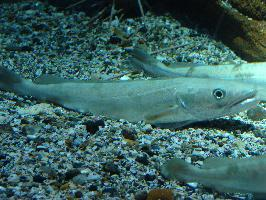
Cunoscut și ca
- Hejk
- Mořská štika
Greutăți și măsuri
| Lungime | de la 80 la 100 cm |
|---|
Date biologice
| Durata de viață | 20 r |
|---|
Descrierea animalului
The European hake, scientifically known as Merluccius merluccius, is a significant species in the marine ecosystems of the North Atlantic Ocean and the Mediterranean and Black Seas. This species is not only an essential component of its natural habitat but also holds considerable value in commercial fishing industries across Europe. The European hake is a demersal fish, preferring to inhabit the sea bottom, though its depth range can vary from shallow waters to depths of up to 1,000 meters, depending on the life stage and feeding habits.Morphologically, the European hake has a slender, elongated body that can reach up to 1.4 meters in length, although the average size is commonly around 50 to 70 centimeters. The body coloration of this species is distinctive, with a silver-grey to brownish back and a lighter, almost white belly. This color gradient not only serves as camouflage against predators from both above and below but also aids in its hunting strategy. The European hake has a large head and mouth, equipped with sharp teeth, indicative of its predatory lifestyle. Its diet primarily consists of small fish, cephalopods, and crustaceans.
One of the interesting aspects of the European hake is its reproductive behavior. It is a batch spawner, with the spawning season varying by geographical location. In general, spawning occurs from late winter to early spring. The females can release up to a million eggs, which are then fertilized externally. The larvae are pelagic, initially living in the open water and gradually descending to the bottom as they mature.
The European hake has been subject to extensive fishing pressure due to its popularity as a food fish. It is esteemed for its delicate white flesh and subtle flavor, making it a preferred choice in many culinary traditions across Europe. The fish is often marketed fresh, frozen, or processed and can be prepared in various ways, including baking, frying, and grilling.
Despite its commercial importance, the European hake populations have faced challenges due to overfishing. This has led to the implementation of conservation measures, including quota systems and the establishment of marine protected areas, aimed at ensuring sustainable fisheries and the long-term survival of the species. Scientific research and monitoring continue to play a crucial role in understanding the biology and ecology of the European hake, which is vital for the development of effective management strategies.
In summary, the European hake is a fascinating species with a significant ecological and economic role. Its biology, behavior, and interactions within marine ecosystems underscore the complexity of marine life and the importance of sustainable practices to preserve these invaluable resources for future generations.
Fotografii noi cu animale
Top 10 animale
- Dolphin gull (Leucophaeus scoresbii)
- Diana monkey (Cercopithecus diana)
- Moustached guenon (Cercopithecus cephus)
- Galápagos tortoise (Geochelone nigra complex)
- Japanese macaque (Macaca fuscata)
- Stone loach (Barbatula barbatula)
- Russian tortoise (Testudo horsfieldii)
- Greek tortoise (Testudo graeca)
- Common flying dragon (Draco volans)
- Vendace (Coregonus albula)